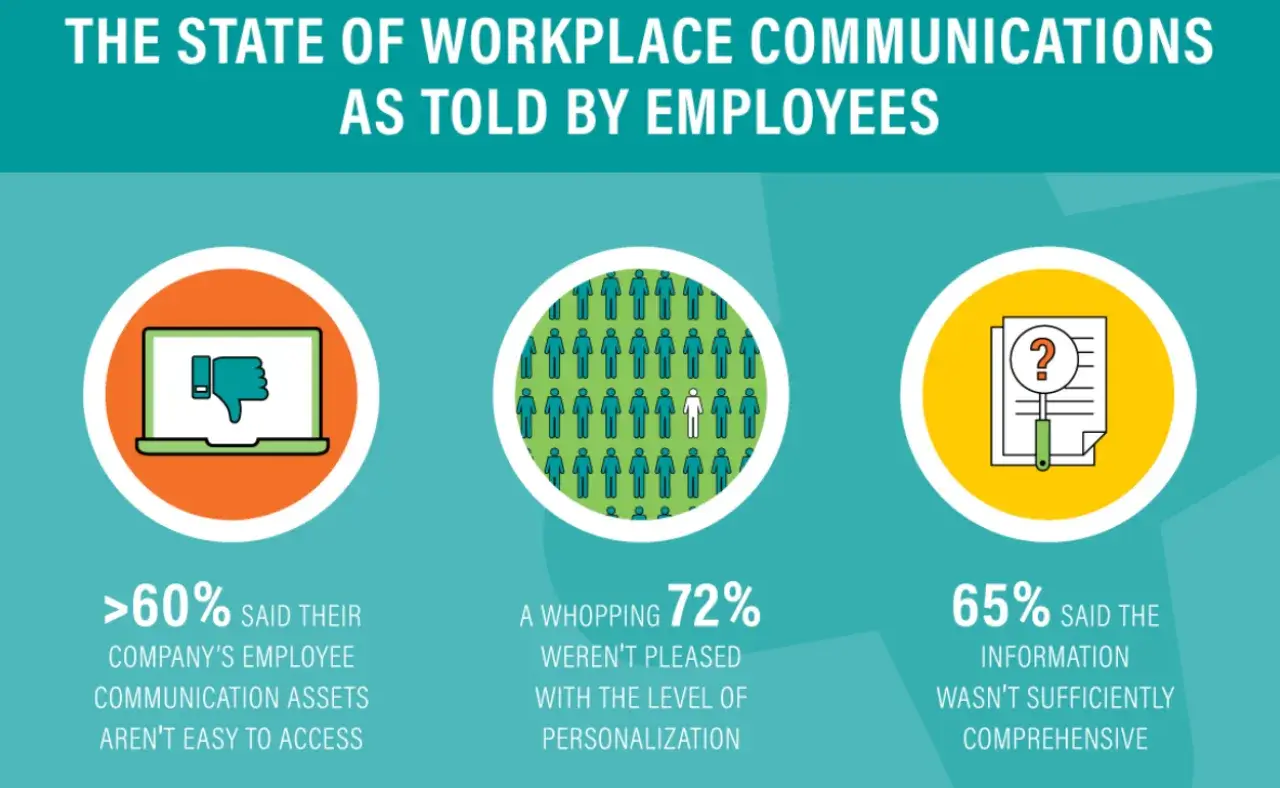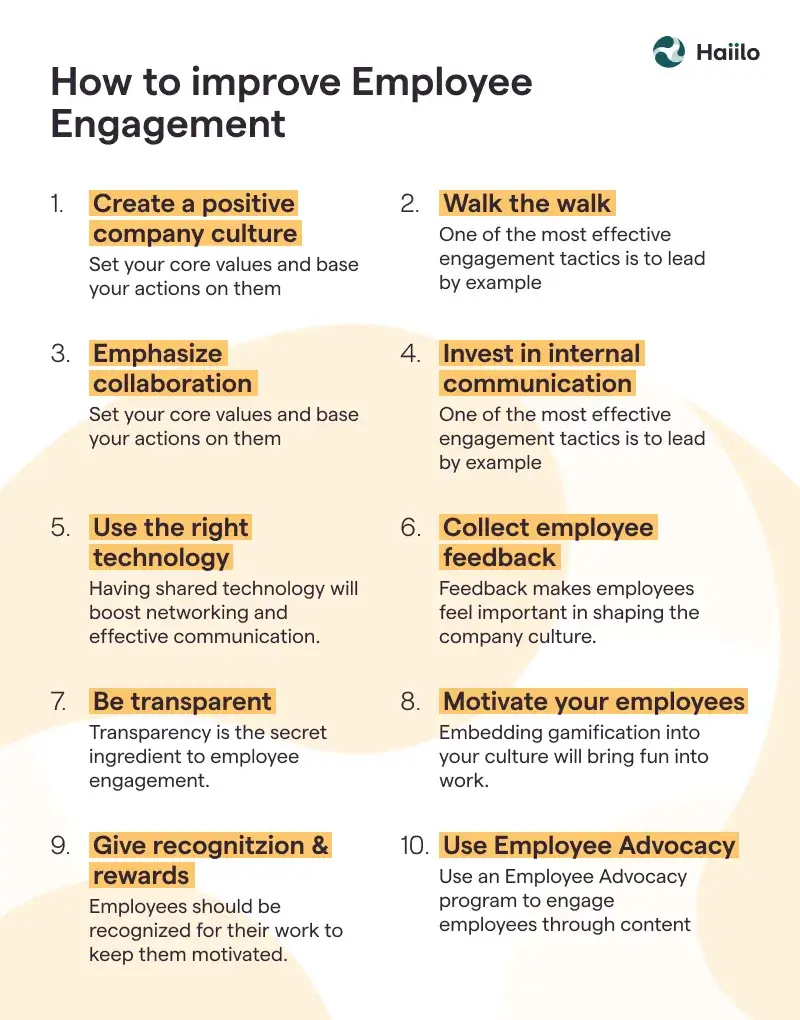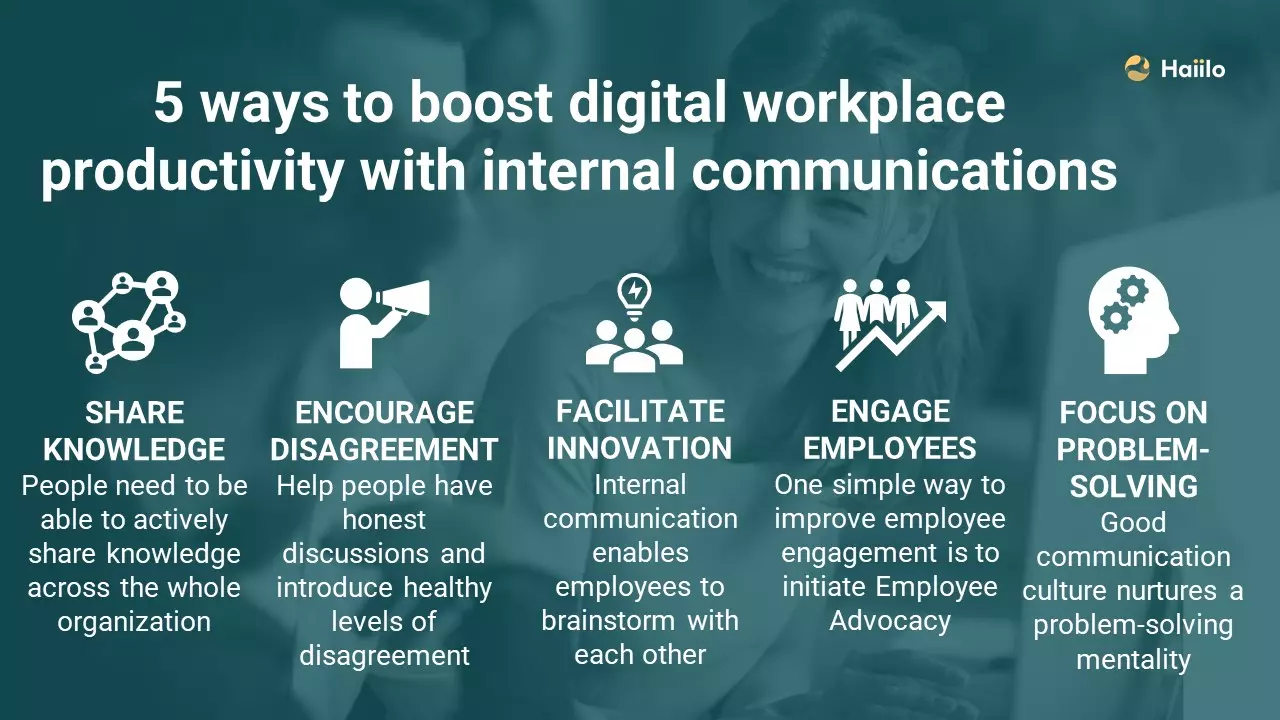Your internal communications have a great impact on the way your employees feel about your company.
Right now, most companies are well aware of the importance of having an engaged workforce. However, workplace statistics are alarming: 70.1% of employees don’t consider themselves very engaged.
📕 Download our new eBook “How to Boost Internal Communication” and learn how to build a great internal communications strategy!
Think about it: when your employees are engaged, they are motivated, they feel valued and recognized by their managers, their productivity goes up, and most importantly — they believe in you and in your product.
And when your employees believe in your product, they’re unstoppable.
Engaged employees won’t hesitate to give the best of themselves to grow your business, they’ll provide the best customer service you can ever imagine, and they’ll protect your company’s image on social media no matter what.
In other words, having engaged employees on board is the key to building a skyrocketing business!
Now, the question is: how do you actually reach this point where your employees are engaged and they fully believe in your brand?
Driving Employee Engagement through Great Internal Communications
When it comes to employee disengagement, the issue is not your workforce but your organization. More specifically, your internal communications may be one of the main reasons why some of your employees don’t feel engaged.

We’ve interviewed Tom Haak, founder and director of the HR Trend Institute, on the importance of internal communications in the workplace.
According to Tom, “having an effective internal communication in place is the key to improving employee engagement. A better focus on listening and continuous listening is required. Employees’ thoughts and suggestions matter and listening to them can be beneficial to the organization in many different ways”.
💡You can read the full interview here 👉 Tom Haak on How to Improve Engagement in the Workplace
Internal communication is a key driver of employee engagement

Even though internal communications play an important role in building an engaged workforce, it seems that most companies are not there yet: 60 percent of companies don’t have a long-term internal communication strategy.
What’s more, 72 percent of employees don’t have a full understanding of the company’s strategy!
The University of Zagreb found that when employees are happy with their companies’ internal communication, they are far more likely to be engaged at work than those who are not. “What matters most is that internal communication and employee engagement ‘feed’ each other in a continuous virtual circle,” they wrote.
5 Ways Great Internal Communications Can Boost Employee Engagement
Let’s see how effective internal communications can actually improve employee engagement at your workplace:
1. Proactive Communication Keeps Everyone in the Loop
The way we’re consuming information has changed: we expect the information to find us rather than having to look for it.
No one likes feeling that they are kept in the dark, or that they’re “always the last to know”. The same goes in the workplace.
Learning about changes in your business through an external source can be extremely demoralizing, so it makes sense that 65% of companies see making sure that everyone is on the same page as one of the biggest communication challenges they’re facing.
Related: Internal Communication: Definition, Challenges and Top Reasons Why It’s More Important than Ever
To keep your employees engaged, you’ll need to adapt your internal communications to their expectations. The keyword here is instant information.
More and more companies are implementing employee communications app so they can instantly inform their employees about business news like project scope changes, important new clients, new employees or internal reshuffling.
When all your employees are on the same page, they’re more likely to feel that they’re part of the business, which is the essence of employee engagement.
2. Internal Communications Drive Employee Productivity
Effective internal communication helps employees to quickly find what they need to do their jobs. It reduces frustration and increases loyalty, because everyone wants to be able to do their jobs successfully and efficiently.
Think about it: employees spend on average 2.5 hours a day looking for the information they need to do their jobs. That’s more than one week of work lost every month!

Poor internal communications have a tremendous impact on employees’ productivity and their ability to meet their targets:
- 44 percent of employees say that poor communication has caused delays or failure to complete projects
- 18 percent of employees say that lack of information has led to the loss of a sale
- 55 percent of workers say poor internal communications cause them to spend several hours or more each week on work they wouldn’t otherwise need to do.
At the end of the day, it’s your employees’ motivation and well-being that is impacted by poor internal communications.

When employees feel like they are wasting time on unnecessary work, they feel frustrated and are less likely to feel engaged with the organization as a whole.
Related: 5 Ways Effective Internal Communication Can Boost Employee Productivity
3. Two-Way Communications Empower Employees
The old days of top-down communications are over! How can you engage your employees if you don’t actually communicate with them?
Internal communication is not about sending out information to the employees. It’s about enhancing dialogues, having a good understanding of employees’ expectations, and making sure that they are heard.
Indeed, your employees want to be listened to, they want to be given the opportunity to implement new projects that impact your business’s bottom line.
A new generation — gen Z — is entering the workplace. Some of them are already working and they have set their own expectations: they want their employer to give them a say when it comes to making important decisions for the business. They want to continuously innovate and develop new skills. In other words, they want to be empowered!

Because of the war for talent we’re living in, gen Z employees won’t hesitate to quit their job if they don’t feel heard or valued in their current job.
You may want to redefine your internal communications strategy if you want to engage and retain them!
Related: Employee Empowerment: Where to Start and How to Do It Right
Companies are embracing new managerial approaches that involve reverse mentoring, reverse feedback and hackathons.
All these new approaches have one thing in common: they involve transparent and open communication.
You will need to have the adequate employee communications app in place to adopt these new ways of working!
4. When Teams Communicate Efficiently, They Feel Connected
Good internal communication connects employees with other people in the same office or business who can serve as role models, mentors or even just tactical guides for them. It boosts engagement among younger workers, who get valuable workplace guidance and a personalized onboarding experience from more experienced employees.
Great employee communications also reduce loneliness and isolation in the workplace, and further strengthens bonds between employees in different roles.
Think about it: nowadays, 66 percent of companies allow remote work and 16 percent are fully remote. However, some of them struggle to help their employees feel connected to the business.
Related: How to Truly Connect With Employees
With instant and transparent communication, you help your remote workers keep up with the business news on a daily basis all while connecting them with the rest of the team. At the end of the day, you help them feel engaged. It’s a win-win situation!

5. Internal Communications Make Work More Fun
Employee engagement is not only about transparent and two-way communications, it’s also about making work a bit fun!
Of course, you need to share business news and industry trends to your employees, but that doesn’t mean that you can’t add some fun to your internal communications.
Related: Employee Engagement: How to Spread Positivity Throughout Your Workplace
For example, you can share the latest company news in a newsletter that you would send to your employees, or you can make it a bit more entertaining by sharing the news in a video that you would share through an app where your employees can react to it! When one of your account managers closes a deal, you can share the news in your next sales review meeting, or you can create a personalized post that you would share with all your employees to congratulate them. When one of your employees retires, you can ask to their teammates what kind of surprise they would like to prepare, or you can launch a poll through your communications app.
Your employees spend eight hours or more a day at your office so don’t forget to make work a bit more fun!
Related: 5 Internal Communications Best Practices for Driving Engagement [Infographic Included]
Another way to spice up your internal communications is by encouraging employees to create their own posts they would share with their colleagues.
You can for example encourage them to write a blog post or create a video where they would share their best practices or guidelines to new recruits. Again, it’s all about empowering your employees!
Takeaways
Internal communications have a tremendous impact on employee engagement. When employees are instantly informed about the latest business news and are connected with the rest of the team, they feel less frustrated or isolated. When they are encouraged to actively contribute to the internal communications — either through two-way communications or content creation — they feel valued, supported and empowered. Put differently, internal communication is the key to building a culture of employee engagement!









